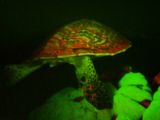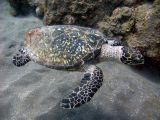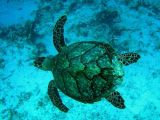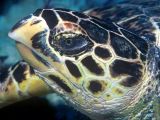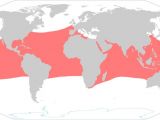In late July, divers exploring the waters off the coast of the Solomon Islands in the South Pacific came across a red and green glowing sea turtle that, at first glance, seemed to them an aquatic UFO of sorts.
Very much excited about their find, the divers filmed the odd-looking creature. The video, available after the jump, was released by National Geographic earlier this week.
Sorry, it wasn't an alien turtle come to visit Earth
The fluorescent creature that National Geographic explorer David Gruber and fellow divers came across near the Solomon Islands in the South Pacific was a hawksbill sea turtle.
The species, whose more official name is Eretmochelys imbricata, populates oceans all across the globe. Its body is ever so slightly flattened and its arms are shaped like flippers. These adaptations allow it to swim in open waters with surprising ease.
While perfectly equipped for life in the open ocean, hawksbill sea turtles are often found in shallow lagoons and near coral reefs, where they feed on sea sponges, algae and jellyfish.
The species can grow to measure up to 1 meter (around 3 feet) in length and weigh 80 kilograms (180 pounds). These creatures are called hawksbill sea turtles because of their distinctive and quite sharp curved beaks, which they rely on to feed.
Presently, the International Union for the Conservation of Nature lists Eretmochelys imbricata as a critically endangered species, with unsustainable fishing practices being partly to blame. Thus, many such sea turtles die after getting caught in nets.
Glowing reptiles have never before been seen in the wild
Biofluorescence, which is when an organism absorbs light, transforms it and then beams it back as a different color, isn't exactly breaking news in the natural world. In recent years, many species of corals, fish, sharks and other marine creatures have been documented to be capable of biofluorescence.
However, National Geographic explorer David Gruber and his colleagues say the hawksbill sea turtle they filmed in the South Pacific is the first known instance of biofluorescence observed in a reptile in the wild.
“It was such a short encounter. It bumped into us and I stayed with it for a few minutes. It was really calm and letting me film it. Then it kind of dove down a wall, and I just let it go,” researcher David Gruber described the uncanny experience in an interview, as cited by Live Science.
Experts suspect the sea turtles have evolved to glow either to blend in with nearby coral reefs or maybe to better communicate with one another. However, further studies are needed to confirm this theory.
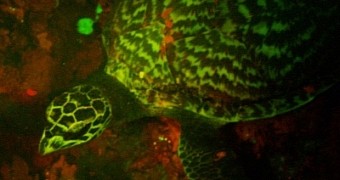
 14 DAY TRIAL //
14 DAY TRIAL // 

